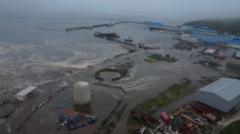What Do We Know About the Damage So Far?

Understanding the Impact of the 8.8 Magnitude Earthquake Off Russia's Far Eastern Coast
On a seemingly ordinary Wednesday, the world was jolted awake by a seismic event that would send shockwaves throughout the Pacific. An 8.8 magnitude earthquake struck near Russia's Kamchatka Peninsula, resulting in tsunami warnings across multiple countries. This article delves into the details of this powerful earthquake, its immediate aftermath, and the broader implications for the affected regions.
The Earthquake: An Overview
At approximately 11:25 AM local time (00:25 AM BST), the earthquake struck with a force that is believed to be one of the strongest ever recorded. The epicenter was located about 119 km east-southeast of Petropavlovsk-Kamchatsky, at a depth of 19.3 km (12 miles). Initially recorded as an 8.0 magnitude event, it was later revised to 8.8, aligning it with some of the most significant earthquakes in history.
The Tsunami Warnings: A Global Response
The seismic activity instigated immediate tsunami warnings across the Pacific, compelling millions to evacuate their homes in countries such as Japan, Russia, and the United States. Alerts also extended to regions as far away as China, the Philippines, Indonesia, New Zealand, Peru, and Mexico. This widespread response underscores the global nature of seismic events and the interconnectedness of coastal safety in the face of natural disasters.
Effects in Russia: A Close Encounter with Nature
Reports from Severo-Kurilsk, a town in Russia, indicated that large waves surged past buildings, flooding the port and a fish processing facility. Vessels that were once securely moored were swept away, showcasing the immediate destructive power of the tsunami. Additionally, the power grid in the Sakhalin region suffered damage, leaving residents grappling with both the earthquake and its aftereffects.
Japan's Evacuation Efforts
In Japan, approximately 1.9 million people received evacuation orders. Authorities urged residents to seek higher ground as a precautionary measure. In the city of Hokkaido, some individuals resorted to sheltering on the rooftops of buildings to escape the anticipated tsunami waves. The country's preparedness for such disasters reflects its historical experiences with seismic activity.
Tsunami Predictions and Their Uncertainty
Officials in Hawaii warned of potential 10-foot waves, but as of the last updates, no significant waves of consequence had been observed. Hawaii’s Governor, Josh Green, emphasized the need for caution, indicating that it would take at least two to three more hours to assess the situation fully. The uncertainty surrounding tsunami predictions highlights the challenges faced by scientists and emergency responders in the immediate aftermath of such events.
The Science Behind Tsunami Waves
Understanding the behavior of tsunami waves is crucial for effective disaster response. According to Helen Janiszewski, an assistant professor in geophysics, tsunami waves travel at speeds comparable to that of a jet airplane. This means that the time it takes for waves to reach distant shores can be estimated based on the distance from the epicenter. For instance, it takes about eight to nine hours for tsunami waves from Kamchatka to reach the U.S. west coast.
Historical Context: Earthquakes and Tsunamis
This earthquake ranks as one of the most severe in recorded history, tied for the sixth place alongside significant quakes in Chile and Ecuador. The historical context of earthquakes provides valuable insights into their potential impact. For example, the 2004 Indian Ocean earthquake and tsunami, which measured between 9.2 and 9.3 in magnitude, claimed over 227,000 lives, a stark reminder of the catastrophic potential of these natural disasters.
Aftershocks and Continued Monitoring
In the aftermath of the main quake, a series of strong aftershocks have been recorded, prompting ongoing monitoring and assessment of the situation. The unpredictability of aftershocks adds another layer of complexity to disaster response strategies, as communities must remain vigilant long after the initial event.
The Broader Implications of Seismic Activity
The effects of such a powerful earthquake extend beyond immediate physical damage. Economically, regions affected by tsunamis often face long-term challenges, including rebuilding infrastructure, restoring power, and supporting displaced communities. The psychological impact on residents cannot be understated either, as fear and anxiety can linger long after the event.
Preparedness: Lessons from History
Historically, regions that experience frequent seismic activity have developed robust disaster preparedness strategies. These include early warning systems, community education programs, and infrastructure designed to withstand seismic forces. The recent events serve as a reminder of the importance of continued investment in preparedness and response capabilities to mitigate the impact of future seismic events.
Global Cooperation in Disaster Response
The international nature of tsunami warnings highlights the need for global cooperation in disaster response. Countries must work together to share information, resources, and best practices to enhance their resilience to natural disasters. Collaborative efforts can significantly improve the effectiveness of evacuation procedures and emergency response initiatives.
Conclusion: The Need for Awareness and Preparedness
The 8.8 magnitude earthquake off Russia's far eastern coast serves as a stark reminder of nature's power and unpredictability. As global citizens, it is essential to remain informed about seismic activity and understand the potential risks associated with living in vulnerable regions. Preparedness, awareness, and community resilience are key factors in minimizing the damage caused by such natural disasters.
FAQs
What are the immediate effects of an earthquake of this magnitude?
Immediate effects can include structural damage, tsunamis, and aftershocks. Communities may experience power outages, infrastructure damage, and disruptions to services.
How do tsunami warnings work?
Tsunami warnings are issued based on seismic activity that indicates a potential tsunami risk. Monitoring stations use data from seismic sensors and ocean buoys to detect changes in wave patterns.
What should I do during a tsunami warning?
During a tsunami warning, it is crucial to evacuate to higher ground immediately. Stay tuned to local news for updates and follow the instructions of emergency services.
How can communities prepare for earthquakes and tsunamis?
Communities can prepare by establishing early warning systems, conducting drills, educating residents about evacuation routes, and reinforcing infrastructure to withstand seismic forces.
As we reflect on the implications of this earthquake, we must ask ourselves: How can we enhance our preparedness for natural disasters in our own communities? #EarthquakePreparedness #TsunamiWarnings #NaturalDisasters
```Published: 2025-07-30 09:00:22 | Category: technology



